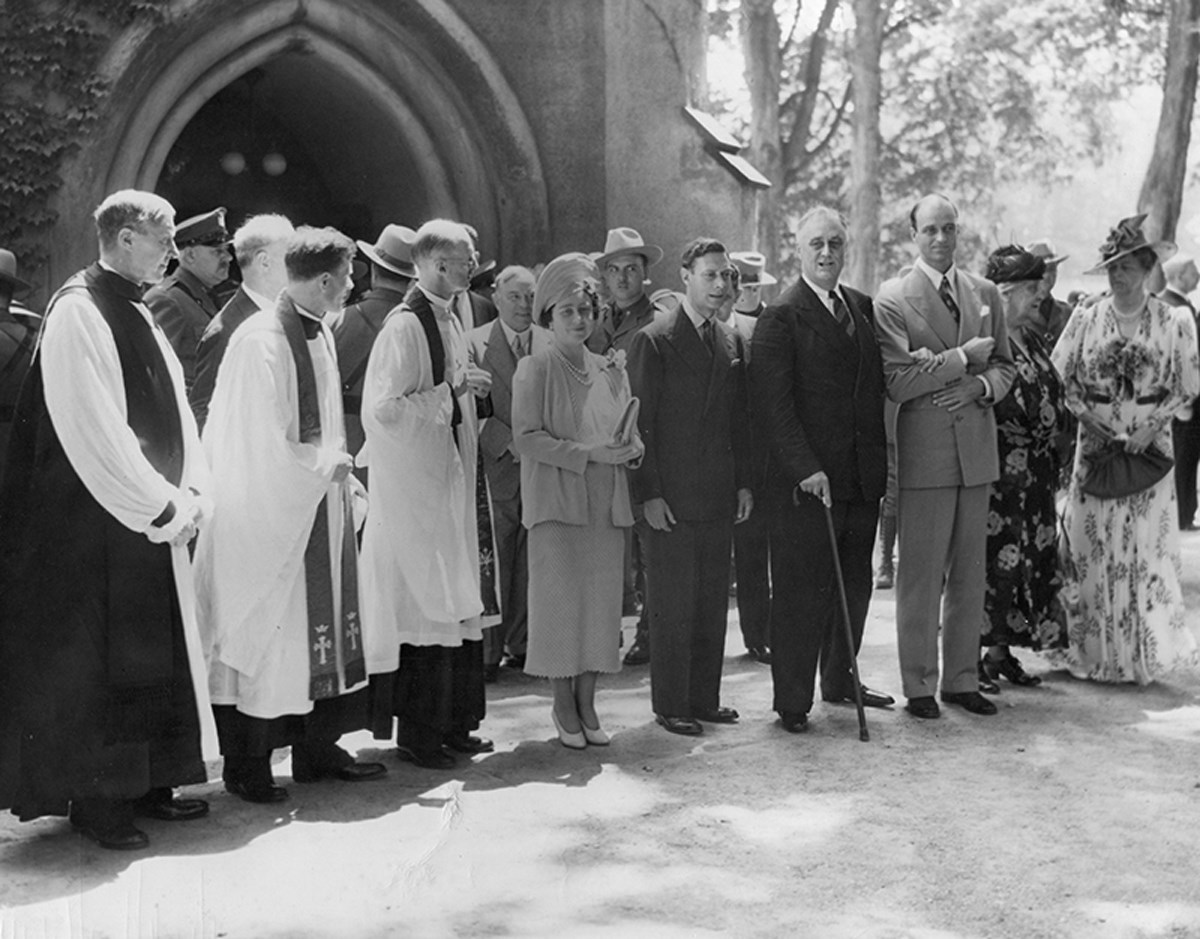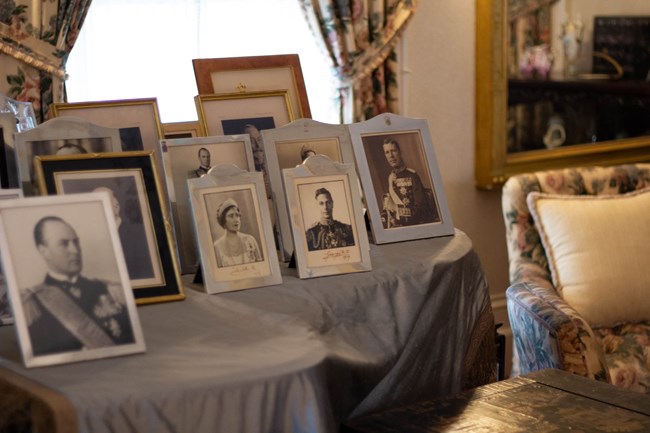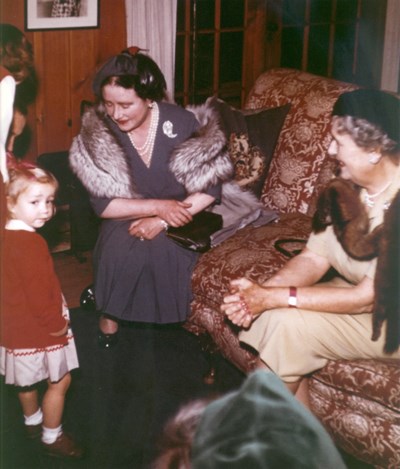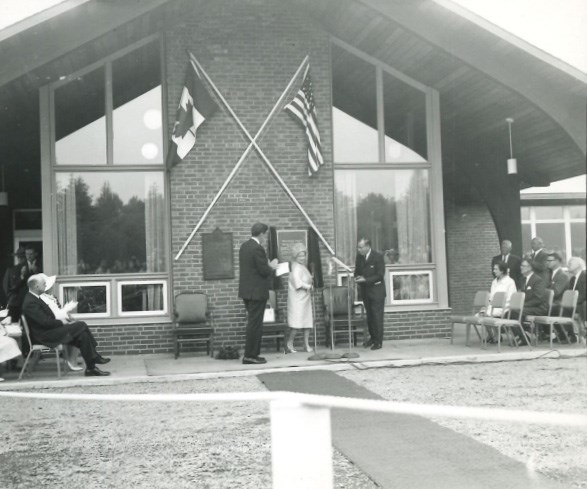
President Franklin D. Roosevelt with King George, Queen Elizabeth, First Lady Eleanor Roosevelt and Sara Delano Roosevelt in front of St. James Church, Hyde Park, New York, June 11, 1939. Courtesy of Franklin D. Roosevelt Presidential Library. In 1939, President Franklin D. Roosevelt invited King George VI and Queen Elizabeth to the United States. It was the first time a reigning British monarch had visited this country. Their visit was not a social call. With Europe on the brink of war, FDR planned every detail of the royal visit to win public support for the United Kingdom at a time when most Americans remained staunch isolationists. The Royal couple arrived in Washington on June 8, 1939 to cheering crowds lining the streets. After two days of receptions, dinners, and a tour to Mount Vernon. Next on their itinerary, was a visit to Hyde Park, where they were treated to a more relaxed formality. They attended Sunday service at St. James Episcopal Church and were served hotdogs at a picnic with the Roosevelts at Top Cottage. The King and Queen presented a copy of a book, The Royal Record of Tree Planting: The Provision of Open Spaces, Recreation Grounds, & Other Schemes, and inscribed to FDR “on the occasion of [their] visit to Hyde Park.” This handsome cloth bound volume, gilt-stamped with the royal coat of arms is a detailed list of the trees that were planted in honor of the King’s coronation in 1937 throughout the United Kingdom, the British Empire, and other nations, including the United States.1 This was certainly a meaningful gift to the President whose appreciation and interest in trees was well-known. In addition to the three billion trees planted to revitalize U.S. forests and agricultural ecosystems during the New Deal, FDR also planted half a million trees on more than two hundred acres of his home in Hyde Park.2 Today, the book remains in FDR's Study at Springwood. The President's mother, Sara Delano Roosevelt, redecorated the Music Room at Springwood in preparation of the Royal visit. New chintz window treatments were ordered and all the furniture in the room was reupholstered. Here, the Roosevelts proudly displayed a collection of European royal portraits autographed to Sara. To express their gratitude for a gracious hostess, King George VI and Queen Elizabeth followed suit, presenting Sara their autographed portraits. They mingle among earlier portraits of the King’s parents, George V and Queen Mary. 
Royal portraits autographed to Sara Roosevelt displayed on the piano in the Music Room at Springwood. NPS Photo. The Royal Family’s 1940 Christmas card to the Roosevelts, currently on display in the President’s Study at Springwood, showed the Royal couple standing in the rubble of a badly damaged Buckingham Palace. The King and Queen signed the card “With best wishes for Christmas and the New Year from George R.I. Elizabeth R.” The powerful and moving card (see Photo Gallery below) showed the resilience of the British public during their darkest hour and served as a plea for help to the President. Both the President and the First Lady would do their part to answer that call. In 1942, the Queen invited Eleanor Roosevelt to visit the Royal Family in London, and to inspect the war-time conditions of the British people and American troops. Eleanor’s tour throughout the United Kingdom lasted a month. During her stay with the Royal Family, the First Lady was instructed to close the curtains over the shattered windows (which were damaged by a German bomb that struck palace’s courtyard) at night so that Nazi pilots couldn’t target Buckingham Palace. Even in the palace, Eleanor witnessed the rationing of water, food, and other basic supplies; according to Roosevelt “there was a plainly marked black line in my bathtub above which I was not supposed to run the water. We were served on gold and silver plates, but our bread was of the same kind of war bread every other family had to eat, and…nothing was served in the way of food that was not served in any of the war canteens.”3 Eleanor toured bomb shelters, military hospitals, and American military posts, taking note of the conditions and the needs of the nurses and soldiers, and writing to the President and to General Eisenhower demanding improvements.4 At the request of the Queen, who hoped Mrs. Roosevelt could bring American attention through her syndicated newspaper column My Day, Eleanor paid special attention to the role of women in the British war effort during her expedition.5 The First Lady’s tour was a triumph, bringing the alliance between the two nations, and the Roosevelts and the Royal Family, closer than ever before. In her autobiography, the First Lady recalled: “The King and Queen treated me with the greatest kindness. The feeling I had had about them during their visit to the United States, that they were simply a young and charming couple, who would have to undergo some very difficult experiences, began to come back to me, intensified by the realization that they now had been through these experiences and were anxious to tell me about them. In all my contacts with them I gained the greatest respect for both the King and Queen…the fact that both of them were doing an extraordinarily outstanding job for their people in the mist trying times stood out.”6 
A photograph of the Royal family hosting Eleanor Roosevelt's visit to Buckingham Palace, 1942. Roosevelt included this image in her autobiography, published in 1958. Photo by Cecil Beaton, (c) Estate of the Artist. After the end of the war and Franklin Roosevelt’s death in 1945, Eleanor was again invited to the United Kingdom by the Royal Family in April of 1948 for the unveiling of a statue, honoring the late President and his friendship to the British people. Eleanor spent the weekend before the unveiling with the royals at Windsor Castle. Queen Mary the Queen Mother (mother of King George VI) led Mrs. Roosevelt through the halls and galleries of the castle; Eleanor recalled that Queen Mary knew the histories of all the paintings and decorative objects, just “like [her] mother-in-law [Sara Delano Roosevelt] at her Hyde Park home.”7 What stuck with Eleanor the most from her time at Windsor Castle was her interactions with Princess Elizabeth. Princess Elizabeth was “still a young girl…but very serious minded.” The Princess asked Eleanor about her inspection of historic homes being restored by female law-offenders as a form of rehabilitation, and the former First Lady shared her optimism for the program. Eleanor found the Princess’s concerns refreshing; “[w]hat stuck with me at the time was that this young princess was so interested in social problems and how they were being handled...I have seen Princess Elizabeth on several occasions since she became queen. Her loveliness does not change but she seems to me still more serious, as one might expect her to be under the burden of her duties.”8 Winston Churchill, who had served alongside Franklin Roosevelt as the leader of his nation during the war, joined Mrs. Roosevelt and the Royal Family for the dedication; they discussed the design for the statue of FDR; “the sculptor, Sir William Reid Dick, strongly felt that Franklin should be depicted standing, facing into the wind. But Winston Churchill, who was an artist himself, took issue. He argued that because Franklin could not walk the statue should show him in a sitting position.” After a speech by the King at the dedication ceremony, held on the third anniversary of the President’s death, Eleanor pulled a cord and the draping over the statue dropped, revealing the statue. After seeing the statue of her husband, she felt that FDR was depicted as a youthful and strong man and noted that is how he would have liked to have been remembered. Although she was invited to attend the coronation of Queen Elizabeth II in 1953, Eleanor was unable to attend because of a five-week tour of Japan9 but was very touched by the invitation.10 Mrs. Roosevelt was, however, interested in the coronation and was able to watch footage of the ceremony while in Japan: “The YWCA [Young Women’s Christian Association] kindly provided us with some tea and sandwiches at eight so we could go directly to the theatre and see the Coronation film of Queen Elizabeth II. I think this film was both impressive and moving. The Queen has a radiant and gentle personality but there is no lack of strength or determination in this light young figure and in her serious face. She looked weary as she waved to people from the balcony of Buckingham Palace at the end of the day. It must have been a long and emotional experience and for the Queen Mother, too, thinking of her own husband's coronation not so many years ago and all that she has been through since then which must have passed through her mind as she and Princess Margaret, with little Prince Charles between them, watched the coronation ceremony.”11 A book detailing Queen Elizabeth’s coronation was found at Val-Kill, Eleanor’s home, at the time of her death in 1962 and appears on an auction inventory list of her personal belongings. 
Queen Elizabeth, the Queen Mother, meeting Eleanor Roosevelt's granddaughter, Nina, in the living room at Val-Kill Cottage. November 1954. Photograph by Dr. A. David Gurewitsch. Used with permission. Eleanor Roosevelt’s path would continue to cross with members of the Royal Family. In November of 1954, Queen Elizabeth, now the Queen Mother (widow of King George VI and mother of the new monarch, Queen Elizabeth II) returned to the United States. Arriving in New York harbor, the Queen Mother had sailed across the Atlantic aboard the famous Queen Elizabeth; Eleanor Roosevelt had sent flowers to welcome the Queen Mother to the city. She met with Vice President Richard Nixon and toured the Empire State Building, the Metropolitan Museum of Art, and the United Nations. On Election Day, November 2nd, the Queen Mother traveled to Hyde Park and was greeted by Mrs. Roosevelt at the Franklin D. Roosevelt Presidential Library before a wreath laying ceremony at the President’s grave.12 The party then moved to Eleanor’s home, Val-Kill, for lunch; the former First Lady served a traditional Thanksgiving style dinner of turkey, sweet potatoes, and red cabbage. Eleanor’s son, John, grandchildren, her personal physician, Dr. A. David Gurewitsch, and former Secretary of the Treasury under FDR, Henry Morgenthau joined them.13 The following day, November 3rd, Eleanor described the visit in her newspaper column, My Day: Early Tuesday morning I went to the polls to vote and returned home to receive the Queen Mother Elizabeth and her party when they arrived to lunch with me at my cottage. Many things that the Queen Mother does here must have some sadness connected with them, but I am sure this visit to Hyde Park, so different from the one when she came with the King in 1939, must have a particular undertone of sadness. I deeply appreciate Her Majesty's willingness to come and give me this opportunity to see her since, of course, I realize only too well how full every minute of her time has been. Coming to visit me is a sign of loyalty to the past but the Queen Mother and I both know that one must live in the present. She has taken up her duties since her husband died and gone on with all the dedication members of the British royal family have so long shown in their obligations to their country. Queen Mary in her long life gave every member of her family a remarkable example to follow. She never seemed to falter in her duty to the nation. It was a great personal pleasure for me to see the Queen Mother again. She has such winning charm and sweetness and in spite of all the necessary hedging-in that must exist where royalty are concerned, she manages to be a real person with all the normal interests and much more understanding of the life of the ordinary human being than is expected by those who approach her with considerable awe.14 Eleanor Roosevelt would call on the young Queen during her travels to Europe and spoke highly of her leadership and ability as a monarch, which Eleanor first noticed during her first encounter with the then Princess Elizabeth during the First Lady’s visit to Buckingham Palace in 1942. After meeting the Queen in May of 1957, Eleanor shared her respect for the Royal Family in her May Day column: It was very kind of the Queen to receive me, since she had not realized that I was leaving Britain so soon and little Prince Charles had had his tonsils and adenoids out the day before…I have the greatest respect for this young woman who must combine the responsibilities of a Queen with the requirements and emotional stresses of a young mother. I think, too, the British people are fortunate in having the royal family to hold them together. Everywhere you go, you see that the Queen, Prince Philip, the Queen Mother, and Princess Margaret are loved as well as deeply respected.15 
The Queen Mother at the dedication of the visitor center at the Roosevelt Campobello International Park, 1964. Image courtesy of Roosevelt Campobello International Park. Queen Elizabeth II maintained her family’s warm relationship with the Roosevelts by sending her own Christmas cards to Eleanor Roosevelt at Val-Kill. The Queen’s 1959 card was signed “With best wishes for Christmas and the New Year” with a photo of Queen Elizabeth, Prince Philip, Prince Charles, and Princess Anne. The two families shared holiday cards until Eleanor Roosevelt’s death in 1962. The Queen Mother paid respect to Franklin and Eleanor Roosevelt once again in 1967. The Roosevelts’ vacation home on Campobello Island, off the coasts of Maine and Canada, was established as an International Park by President Lydon Johnson and Canadian Prime Minister Lester Pearson in August of 1964. The Queen Mother was invited to dedicate the park’s visitor center in July of 1967. In a speech before the unveiling of the commemorative plaque and official opening of the building, the Queen Mother fondly recalled her visits to Hyde Park, the comradery the Roosevelts offered to the British people during the war, and their personal friendship.16 The close, “special relationship”17 between the United States and the United Kingdom was forged from shared history, language, culture, and traditions. Although diplomatic relations between the two nations had a rocky beginning, and moments of tension throughout the 19th century, the personal friendship of Presidents and Prime Ministers, beginning with Roosevelt and Churchill, and with members of the Royal Family, have greatly improved and continue to reassure the special relationship for both countries. The Roosevelts both identified with the challenges the Royal Family faced as public figures and leaders during the Great Depression and World War II, and, for Eleanor, in the changing, fast paced world that followed. Eleanor Roosevelt was a uniquely outspoken advocate for women, both domestically and internationally, during her times as First Lady, as delegate to the United Nations and beyond; Eleanor found comfort and mutual respect in her personal friendship with Queen Elizabeth the Queen Mother, and Queen Elizabeth II as leading female figures for their nations.
Notes 1 Coronation Planting Committee - The Royal record of tree planting, the provision of open spaces, recreation grounds and other schemes ... in honour of the coronation of His Majesty King George VI. (rct.uk) 2 Franklin D. Roosevelt: Tree Farmer - Home Of Franklin D Roosevelt National Historic Site (U.S. National Park Service) - Viewshed (nps.gov) 3 Eleanor Roosevelt, The Autobiography of Eleanor Roosevelt, Curtis Publishing Company New York, 1958, page 241. 4 Touring the British Homefront (1942) | Eleanor Roosevelt Papers Project | The George Washington University (gwu.edu). 5 Eleanor Roosevelt, “The Autobiography of Eleanor Roosevelt,” Curtis Publishing Company New York, 1958, page 238. 6 Eleanor Roosevelt, “The Autobiography of Eleanor Roosevelt,” Curtis Publishing Company New York, 1958, page 240. 7 Eleanor Roosevelt, “The Autobiography of Eleanor Roosevelt,” Curtis Publishing Company New York, 1958, page 296. 8 Eleanor Roosevelt, “The Autobiography of Eleanor Roosevelt,” Curtis Publishing Company New York, 1958, pages 296 and 297. 9 Will Swift, “The Roosevelts and the Royals,” John Wiley & Sons, New Jersey, 2004, page 30. 10 My Day by Eleanor Roosevelt, May 13, 1953 (gwu.edu). 11 My Day by Eleanor Roosevelt, June 27, 1953 (gwu.edu). 12 Will Swift, “The Roosevelts and the Royals,” John Wiley & Sons, New Jersey, 2004, page 308 13 Edith Evans Asbury, “Turkey is Served to Queen Mother: Elizabeth Gets Thanksgiving Dinner in Hyde Park as Guest of Mrs. Roosevelt,” New York Times, November 3, 1954, page 31 TimesMachine: November 3, 1954 - NYTimes.com 14 Browse My Day Columns | Eleanor Roosevelt Papers Project | The George Washington University (gwu.edu). 15 My Day by Eleanor Roosevelt, May 15, 1957 (gwu.edu). 16 The Sinews of Peace ('Iron Curtain Speech') - International Churchill Society (winstonchurchill.org) 17 John Fenton, “Britian’s Queen Mother Pays Visit to Campobello: She is First Official Tourist to Enter Recpetion Center at the Roosevelt Park,” New York Times, July 14, 1967. TimesMachine: July 14, 1967 - NYTimes.com |
Last updated: April 27, 2023
